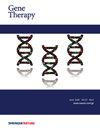Adeno-associated virus serotype 2 capsids with proteolytic cuts by trypsin remain intact and potent
IF 4.5
3区 医学
Q1 BIOCHEMISTRY & MOLECULAR BIOLOGY
引用次数: 0
Abstract
Recombinant adeno-associated viral (AAV) vectors have emerged as prominent gene delivery vehicles for gene therapy. In the journey of an AAV vector, AAV vectors can be exposed to different proteolytic environments inside the production cells, during the cell lysis step, within the endosome, and finally inside the cell nucleus. The stability of a modified AAV serotype 2 (AAV2) capsid was evaluated via a proteolytic approach using trypsin and other proteases and both denaturing and non-denaturing analytical methods. Trypsin digestion of the AAV2 capsids resulted in clips of the capsid proteins at the C-terminus as confirmed by denaturing methods including SDS-PAGE, CE-SDS, Western blot, and RPLC-MS. It was found that the AAV2 capsid with clips not only remains structurally intact, as confirmed by non-denaturing methods including SEC, thermostability testing, and cryo-EM, but also remains potent, as confirmed in a cell-based potency assay. This finding reveals that AAV2 capsid with proteolytic cuts remains intact and potent since the icosahedral three-dimensional structural arrangement of AAV capsid proteins can protect the clipped fragment from being released from the capsid, such that the AAV capsid remains intact allowing for the functionality to be maintained to deliver the DNA in the host cell. Evaluation of AAV stability using a proteolytic approach and multiple denaturing and non-denaturing analytical methods can provide valuable information for engineering AAV capsids to develop AAV-based gene therapy.

腺相关病毒血清2型衣壳被胰蛋白酶蛋白水解切割后保持完整和有效。
重组腺相关病毒(AAV)载体已成为基因治疗中重要的基因传递载体。在AAV载体的传播过程中,AAV载体可以暴露于生产细胞内、细胞裂解阶段、核内体内以及细胞核内的不同蛋白水解环境中。利用胰蛋白酶和其他蛋白酶以及变性和非变性分析方法,对改良的AAV血清型2 (AAV2)衣壳的稳定性进行了评价。经SDS-PAGE、CE-SDS、Western blot和hplc - ms等变性方法证实,胰蛋白酶消化AAV2衣壳后,在c端产生衣壳蛋白片段。研究发现,带有片段的AAV2衣壳不仅在结构上保持完整,通过非变性方法(包括SEC、热稳定性测试和冷冻电镜)证实了这一点,而且在基于细胞的效价分析中也证实了这一点。这一发现表明,由于AAV衣壳蛋白的二十面体三维结构排列可以保护被剪切的片段不被释放,因此AAV衣壳保持完整,从而维持在宿主细胞中传递DNA的功能,因此具有蛋白水解切割的AAV2衣壳保持完整和有效。利用蛋白水解方法和多种变性和非变性分析方法评价AAV的稳定性,可以为工程AAV衣壳开发基于AAV的基因治疗提供有价值的信息。
本文章由计算机程序翻译,如有差异,请以英文原文为准。
求助全文
约1分钟内获得全文
求助全文
来源期刊

Gene Therapy
医学-生化与分子生物学
CiteScore
9.70
自引率
2.00%
发文量
67
审稿时长
4-8 weeks
期刊介绍:
Gene Therapy covers both the research and clinical applications of novel therapeutic techniques based on a genetic component. Over the last few decades, significant advances in technologies ranging from identifying novel genetic targets that cause disease through to clinical studies, which show therapeutic benefit, have elevated this multidisciplinary field to the forefront of modern medicine.
 求助内容:
求助内容: 应助结果提醒方式:
应助结果提醒方式:


